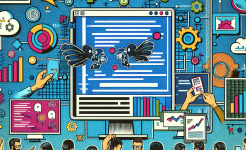In the realm of software development, two prominent approaches have emerged over the years: agile development with its continuous delivery model and traditional development with its phased delivery approach. These two paradigms represent different philosophies, processes, and ways of bringing products to market. Understanding the nuances between them is crucial for development teams, project managers, and stakeholders alike, as it can significantly impact the success of a software project.
Agile development has revolutionized the software industry by emphasizing flexibility, collaboration, and rapid adaptation to change. Continuous delivery, a key tenet of agile, aims to enable software to be released to production at any time with high confidence. On the other hand, traditional development follows a more structured, sequential path, with phased delivery at the end of each distinct phase. This article will delve into the details of these two delivery models, exploring their advantages, challenges, and when each might be most appropriate.
Continuous Delivery in Agile Development
Continuous delivery in agile development is a practice that focuses on automating the software release process. It involves a series of steps, starting from code integration to the final deployment to production. The goal is to have a pipeline that can consistently and reliably deliver new features and bug fixes to the end-users.
One of the significant advantages of continuous delivery in agile is the ability to respond quickly to customer feedback. Since the software can be released frequently, developers can incorporate user suggestions and changes in a timely manner. This iterative approach ensures that the product remains relevant and meets the evolving needs of the market. For example, in a mobile application development project, continuous delivery allows the team to push out small updates regularly, fixing any usability issues or adding new features based on user reviews.
Another benefit is the reduction of risks. By continuously integrating and testing the code, any issues or bugs are identified early in the process. This early detection minimizes the cost and effort required to fix problems later on. In a large-scale enterprise software project, a small bug left undetected during development can lead to significant disruptions when the software is deployed. Continuous delivery helps catch these bugs early, ensuring a more stable and reliable product.
However, continuous delivery also presents some challenges. It requires a high level of automation, which can be complex to set up and maintain. The development team needs to invest time and resources in building and managing the automated pipelines. Additionally, continuous delivery demands a cultural shift within the organization, as it requires close collaboration between development, testing, and operations teams.
Phased Delivery in Traditional Development
Phased delivery in traditional development follows a more linear and structured approach. The development process is divided into distinct phases, such as requirements gathering, design, development, testing, and deployment. Each phase has a set of deliverables and must be completed before moving on to the next one.
One of the main advantages of phased delivery is the clarity and predictability it offers. The well-defined phases and deliverables provide a clear roadmap for the project. This makes it easier for project managers to plan, allocate resources, and set deadlines. For instance, in a large infrastructure project, having a detailed phased plan allows the team to accurately estimate the time and cost required for each stage, ensuring that the project stays on track.
Phased delivery also provides a high level of quality control. Since each phase has specific review points, potential issues can be identified and addressed before proceeding. This reduces the likelihood of major problems occurring during the later stages of the project. In a safety-critical software development project, such as an aircraft control system, the strict phased approach ensures that the software meets the highest standards of reliability and safety.

However, phased delivery has its limitations. The sequential nature of the process can make it less flexible to changes. If new requirements emerge during the development process, it may be difficult and costly to incorporate them without disrupting the entire project schedule. Additionally, the long intervals between deliverables can lead to a lack of feedback from stakeholders, potentially resulting in a product that does not fully meet their expectations.
Comparing the Two Approaches
When comparing continuous delivery in agile development and phased delivery in traditional development, several key differences become apparent. Firstly, the time to market is often shorter with continuous delivery. The ability to release software frequently allows companies to get their products to the market faster, gaining a competitive edge. In contrast, phased delivery typically takes longer due to the sequential nature of the process.
Secondly, the level of flexibility is higher in continuous delivery. Agile teams can adapt to changes quickly, incorporating new features or modifying existing ones based on customer feedback. Phased delivery, on the other hand, is more rigid, making it challenging to accommodate changes without significant rework.
In terms of risk management, continuous delivery spreads the risk throughout the development process by detecting and fixing issues early. Phased delivery, while having quality control checkpoints, may have a higher risk of major issues surfacing towards the end of the project if problems are not identified in earlier phases.
Choosing the Right Approach
The choice between continuous delivery in agile development and phased delivery in traditional development depends on several factors. For projects with rapidly changing requirements and a need for quick time to market, such as in the startup or mobile app development space, continuous delivery in an agile framework is often the better choice. It allows for rapid innovation and adaptation to market dynamics.
On the other hand, for projects where stability, predictability, and strict quality control are paramount, such as in the development of critical infrastructure or regulated industries, phased delivery in a traditional development model may be more appropriate. The well-defined phases and review points ensure that the product meets the required standards.
In some cases, a hybrid approach may also be viable. For example, a project could start with a phased approach to establish a solid foundation and then transition to a more agile, continuous delivery model as the requirements become more stable.
Conclusion
In conclusion, both continuous delivery in agile development and phased delivery in traditional development have their own strengths and weaknesses. Continuous delivery offers speed, flexibility, and early risk detection, making it suitable for projects that require rapid innovation and adaptation. Phased delivery, on the other hand, provides clarity, predictability, and high levels of quality control, making it a good choice for projects with strict requirements and a need for stability.
Ultimately, the success of a software project depends on choosing the right delivery model based on the project's specific characteristics, requirements, and goals. By understanding the differences between these two approaches, development teams can make informed decisions that will lead to the successful delivery of high-quality software products. Whether it's the iterative and flexible nature of continuous delivery or the structured and sequential approach of phased delivery, the key is to align the development process with the needs of the project and the expectations of the stakeholders. As the software development landscape continues to evolve, the ability to select and implement the most appropriate delivery model will remain a critical skill for developers and project managers alike.
ARTICLE TITLE :Continuous delivery in agile development and phased delivery in traditional development ,AUTHOR :ITpmlib

















